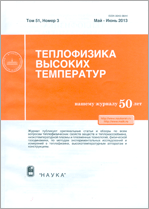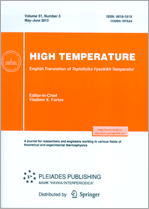|
|
Teplofizika vysokikh temperatur, 2007, Volume 45, Issue 2, Pages 296–315
(Mi tvt997)
|
 |
|
 |
This article is cited in 99 scientific papers (total in 99 papers)
Review
The effect of nonequilibrium excitation on the ignition of hydrogen-oxygen mixtures
N. A. Popov
Skobeltsyn Institute of Nuclear Physics, Lomonosov Moscow State University
Abstract:
The part played by various radicals and excited particles in reducing the induction period is discussed when analyzing the ignition of combustible mixtures under highly nonequilibrium conditions. A review is made of experimental and theoretical investigations of the effect made by atoms of hydrogen and oxygen, electron-excited molecules of $\mathrm{O}_2(a^1\Delta_g)$, and vibrationally excited molecules of $\mathrm{H}_2$ and $\mathrm{O}_2$ on the times of induction and on the shift of the limits of ignition of hydrogen-oxygen mixtures.
The addition of atoms of oxygen and hydrogen to a combustible mixture may cause a significant reduction of the times of induction and the lowering of the temperature limit of ignition of combustible mixtures. However, the latter effect is observed only in the vicinity of the limit of ignition. In the zone of relatively low initial temperatures, the shift of the ignition limit is largely associated with the self-heating of mixture owing to recombination of atomic particles being added. In so doing, the nonequilibrium pattern of the impact hardly shows up. Molecules of singlet oxygen (SO) may be involved in both chain initiation reactions and chain branching reactions. The rates of these processes increase significantly with the temperature of the mixture. However, the temperature increase further causes an increase in the rate of reaction of hydrogen quenching of singlet oxygen $\mathrm{O}_2(a^1\Delta_g)$. The acceleration of deactivation of $\mathrm{O}_2(a^1\Delta_g)$ with increasing temperature, which was previously ignored by researchers, causes an abrupt reduction of the effectiveness of the impact of SO on the times of induction. In the low-temperature region, where the quenching is relatively weak, the effect of $\mathrm{O}_2(a^1\Delta_g)$ on the ignition of $\mathrm{H}_2 : \mathrm{O}_2$ mixtures may be significant in the case of a sufficiently high (in excess of $10^{-2}$ level of relative concentrations of SO.
Vibrationally excited molecules of $\mathrm{H}_2(v)$ may likewise be involved in chain initiation and branching reactions. The available results lead one to assume the possibility of lowering the temperature limit of ignition of hydrogen-oxygen mixtures in the case of intensive excitation of vibrational degrees of freedom of $\mathrm{H}_2(v)$ molecules. However, in the case of electric-discharge excitation (even in $\mathrm{H}_2 : \mathrm{O}_2$ mixtures, in which a significant fraction of discharge energy may be delivered to the vibrational subsystem of $\mathrm{H}_2(v)$), it is quite difficult to attain high levels of vibrational excitation $(T^{\mathrm{H}_2}_v \ge 2000$ К$)$. In a stoichiometric mixture of $\mathrm{H}_2$:air, where the bulk of discharge energy is spent for vibrational excitation of nitrogen molecules, this problem becomes even more complicated.
Received: 06.06.2006
Citation:
N. A. Popov, “The effect of nonequilibrium excitation on the ignition of hydrogen-oxygen mixtures”, TVT, 45:2 (2007), 296–315; High Temperature, 45:2 (2007), 261–279
Linking options:
https://www.mathnet.ru/eng/tvt997 https://www.mathnet.ru/eng/tvt/v45/i2/p296
|


| Statistics & downloads: |
| Abstract page: | 354 | | Full-text PDF : | 161 |
|





 Contact us:
Contact us: Terms of Use
Terms of Use
 Registration to the website
Registration to the website Logotypes
Logotypes








 Citation in format
Citation in format 
